Conflict Management: Communication vs. Interaction Theories Analysis
VerifiedAdded on 2022/11/25
|8
|2031
|335
Essay
AI Summary
This essay provides a comprehensive analysis of conflict management, focusing on two key theories: communication theory and interaction theory. It begins by defining conflict as an unavoidable aspect of organizational life and emphasizes the importance of effective management. The essay delves into the communication theory, highlighting its role in information transmission and its application in resolving conflicts through direct communication and effective communication skills. It also explores the limitations of this theory, such as the time-consuming nature of the process. The interaction theory is then examined, emphasizing its view of conflict as a positive force that can enhance performance and foster innovation. The essay discusses the criticisms of the interaction theory, including the potential for relationship conflicts and disruptions. Finally, it compares the two theories, acknowledging their individual strengths and suitability for different organizational contexts. The essay concludes by underscoring the importance of conflict management for business sustainability, emphasizing the need for managers to understand the root causes of conflict and collaborate to find effective solutions, ultimately leading to improved innovation and implementation.
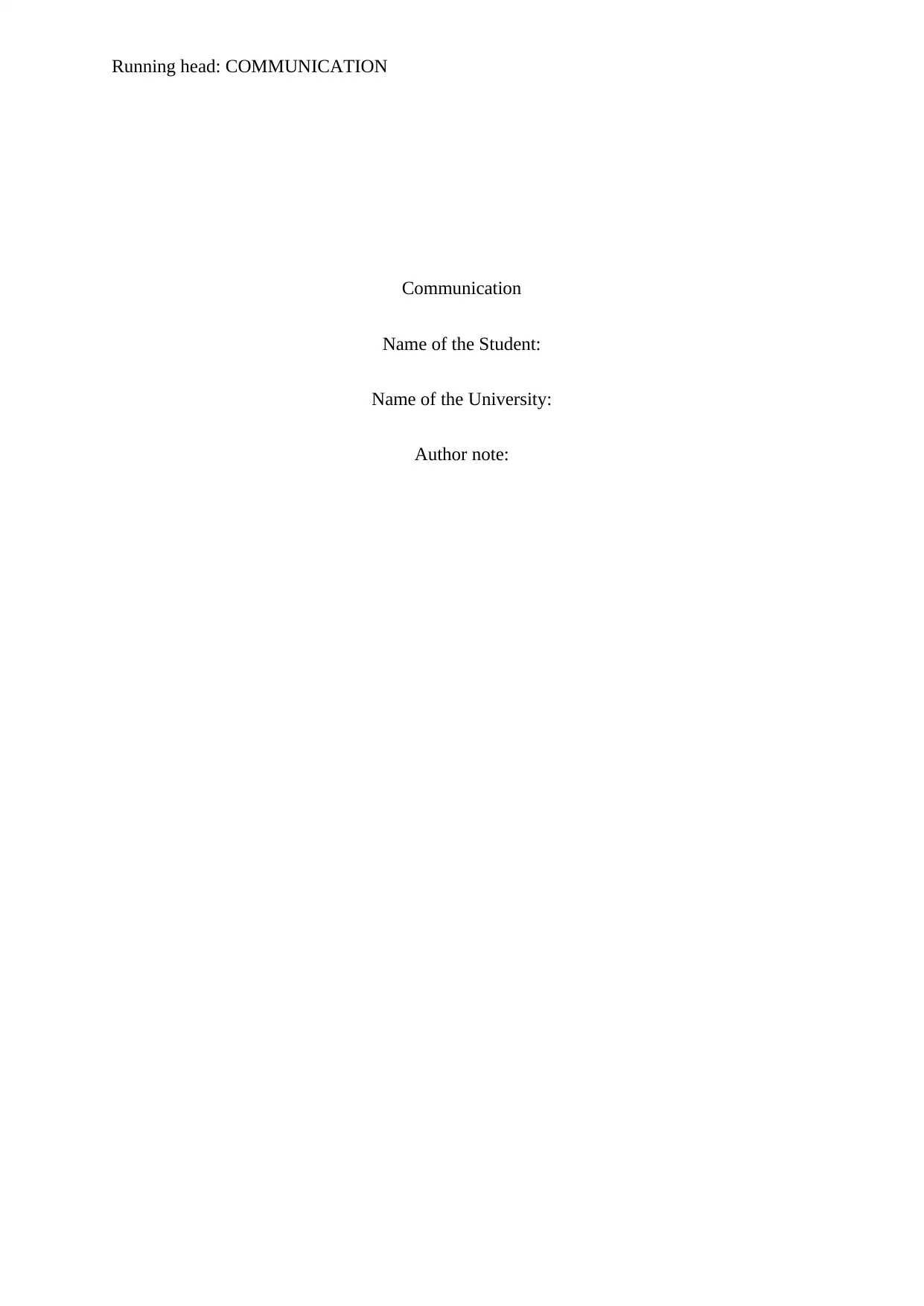
Running head: COMMUNICATION
Communication
Name of the Student:
Name of the University:
Author note:
Communication
Name of the Student:
Name of the University:
Author note:
Paraphrase This Document
Need a fresh take? Get an instant paraphrase of this document with our AI Paraphraser
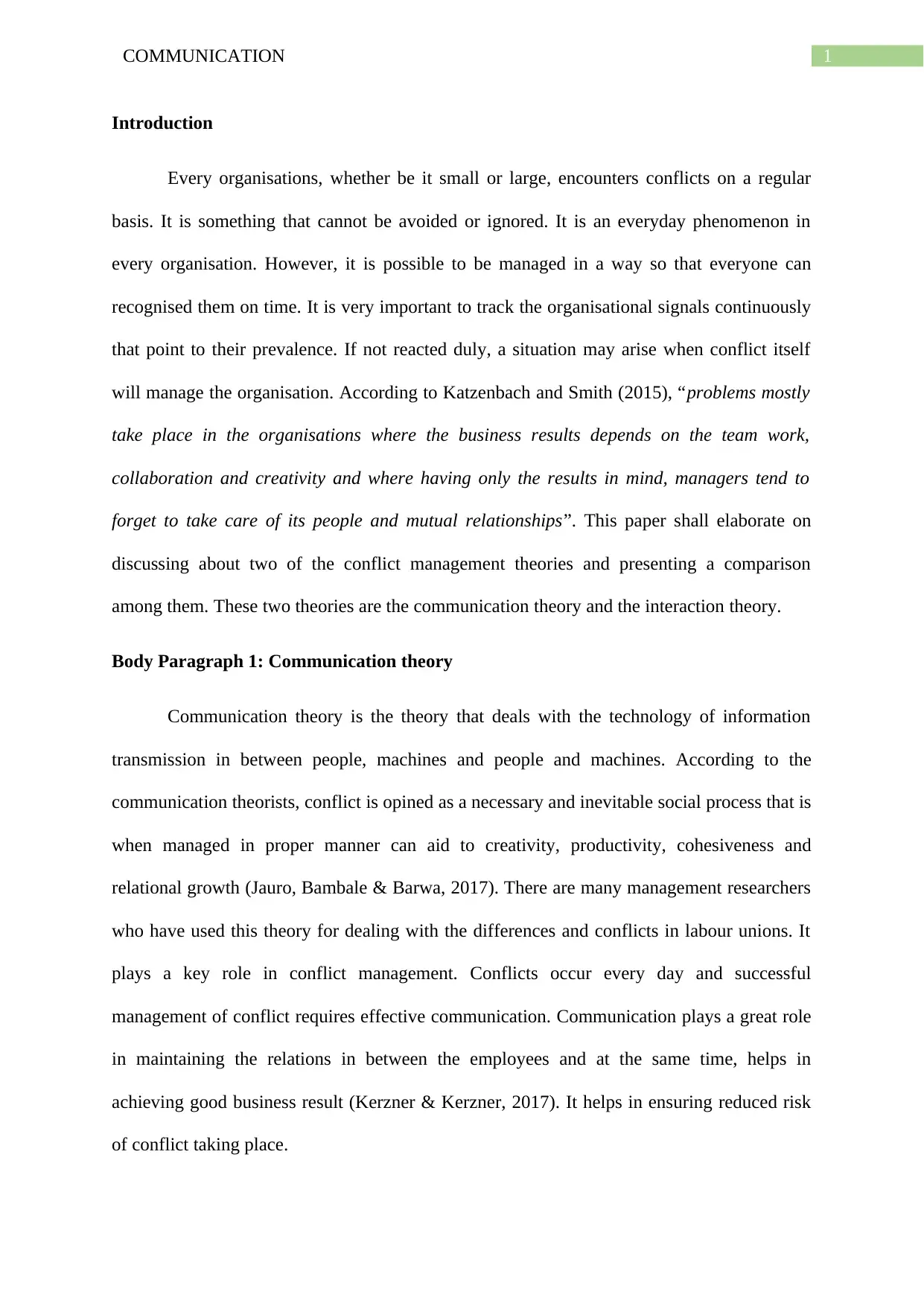
1COMMUNICATION
Introduction
Every organisations, whether be it small or large, encounters conflicts on a regular
basis. It is something that cannot be avoided or ignored. It is an everyday phenomenon in
every organisation. However, it is possible to be managed in a way so that everyone can
recognised them on time. It is very important to track the organisational signals continuously
that point to their prevalence. If not reacted duly, a situation may arise when conflict itself
will manage the organisation. According to Katzenbach and Smith (2015), “problems mostly
take place in the organisations where the business results depends on the team work,
collaboration and creativity and where having only the results in mind, managers tend to
forget to take care of its people and mutual relationships”. This paper shall elaborate on
discussing about two of the conflict management theories and presenting a comparison
among them. These two theories are the communication theory and the interaction theory.
Body Paragraph 1: Communication theory
Communication theory is the theory that deals with the technology of information
transmission in between people, machines and people and machines. According to the
communication theorists, conflict is opined as a necessary and inevitable social process that is
when managed in proper manner can aid to creativity, productivity, cohesiveness and
relational growth (Jauro, Bambale & Barwa, 2017). There are many management researchers
who have used this theory for dealing with the differences and conflicts in labour unions. It
plays a key role in conflict management. Conflicts occur every day and successful
management of conflict requires effective communication. Communication plays a great role
in maintaining the relations in between the employees and at the same time, helps in
achieving good business result (Kerzner & Kerzner, 2017). It helps in ensuring reduced risk
of conflict taking place.
Introduction
Every organisations, whether be it small or large, encounters conflicts on a regular
basis. It is something that cannot be avoided or ignored. It is an everyday phenomenon in
every organisation. However, it is possible to be managed in a way so that everyone can
recognised them on time. It is very important to track the organisational signals continuously
that point to their prevalence. If not reacted duly, a situation may arise when conflict itself
will manage the organisation. According to Katzenbach and Smith (2015), “problems mostly
take place in the organisations where the business results depends on the team work,
collaboration and creativity and where having only the results in mind, managers tend to
forget to take care of its people and mutual relationships”. This paper shall elaborate on
discussing about two of the conflict management theories and presenting a comparison
among them. These two theories are the communication theory and the interaction theory.
Body Paragraph 1: Communication theory
Communication theory is the theory that deals with the technology of information
transmission in between people, machines and people and machines. According to the
communication theorists, conflict is opined as a necessary and inevitable social process that is
when managed in proper manner can aid to creativity, productivity, cohesiveness and
relational growth (Jauro, Bambale & Barwa, 2017). There are many management researchers
who have used this theory for dealing with the differences and conflicts in labour unions. It
plays a key role in conflict management. Conflicts occur every day and successful
management of conflict requires effective communication. Communication plays a great role
in maintaining the relations in between the employees and at the same time, helps in
achieving good business result (Kerzner & Kerzner, 2017). It helps in ensuring reduced risk
of conflict taking place.
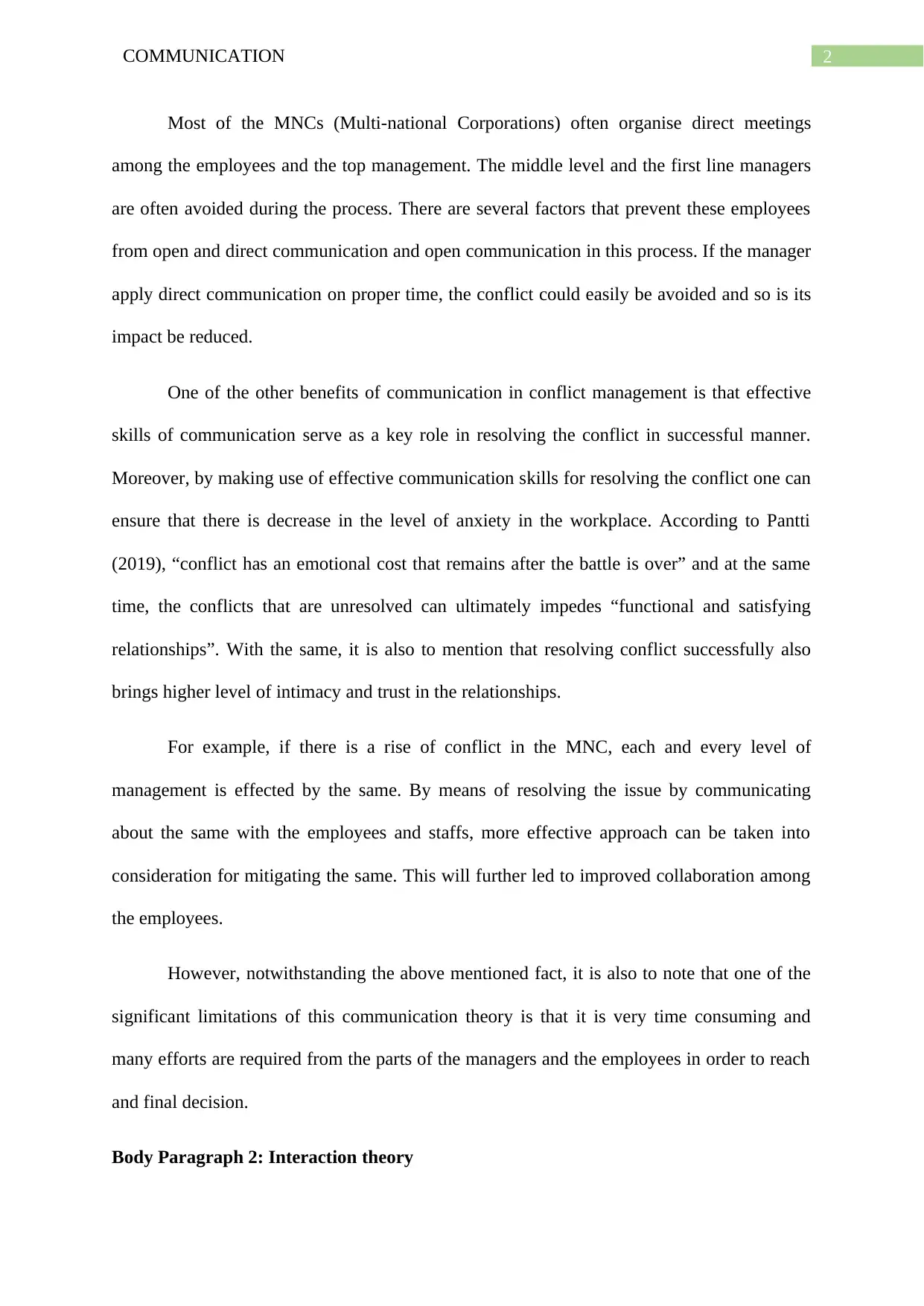
2COMMUNICATION
Most of the MNCs (Multi-national Corporations) often organise direct meetings
among the employees and the top management. The middle level and the first line managers
are often avoided during the process. There are several factors that prevent these employees
from open and direct communication and open communication in this process. If the manager
apply direct communication on proper time, the conflict could easily be avoided and so is its
impact be reduced.
One of the other benefits of communication in conflict management is that effective
skills of communication serve as a key role in resolving the conflict in successful manner.
Moreover, by making use of effective communication skills for resolving the conflict one can
ensure that there is decrease in the level of anxiety in the workplace. According to Pantti
(2019), “conflict has an emotional cost that remains after the battle is over” and at the same
time, the conflicts that are unresolved can ultimately impedes “functional and satisfying
relationships”. With the same, it is also to mention that resolving conflict successfully also
brings higher level of intimacy and trust in the relationships.
For example, if there is a rise of conflict in the MNC, each and every level of
management is effected by the same. By means of resolving the issue by communicating
about the same with the employees and staffs, more effective approach can be taken into
consideration for mitigating the same. This will further led to improved collaboration among
the employees.
However, notwithstanding the above mentioned fact, it is also to note that one of the
significant limitations of this communication theory is that it is very time consuming and
many efforts are required from the parts of the managers and the employees in order to reach
and final decision.
Body Paragraph 2: Interaction theory
Most of the MNCs (Multi-national Corporations) often organise direct meetings
among the employees and the top management. The middle level and the first line managers
are often avoided during the process. There are several factors that prevent these employees
from open and direct communication and open communication in this process. If the manager
apply direct communication on proper time, the conflict could easily be avoided and so is its
impact be reduced.
One of the other benefits of communication in conflict management is that effective
skills of communication serve as a key role in resolving the conflict in successful manner.
Moreover, by making use of effective communication skills for resolving the conflict one can
ensure that there is decrease in the level of anxiety in the workplace. According to Pantti
(2019), “conflict has an emotional cost that remains after the battle is over” and at the same
time, the conflicts that are unresolved can ultimately impedes “functional and satisfying
relationships”. With the same, it is also to mention that resolving conflict successfully also
brings higher level of intimacy and trust in the relationships.
For example, if there is a rise of conflict in the MNC, each and every level of
management is effected by the same. By means of resolving the issue by communicating
about the same with the employees and staffs, more effective approach can be taken into
consideration for mitigating the same. This will further led to improved collaboration among
the employees.
However, notwithstanding the above mentioned fact, it is also to note that one of the
significant limitations of this communication theory is that it is very time consuming and
many efforts are required from the parts of the managers and the employees in order to reach
and final decision.
Body Paragraph 2: Interaction theory
⊘ This is a preview!⊘
Do you want full access?
Subscribe today to unlock all pages.

Trusted by 1+ million students worldwide
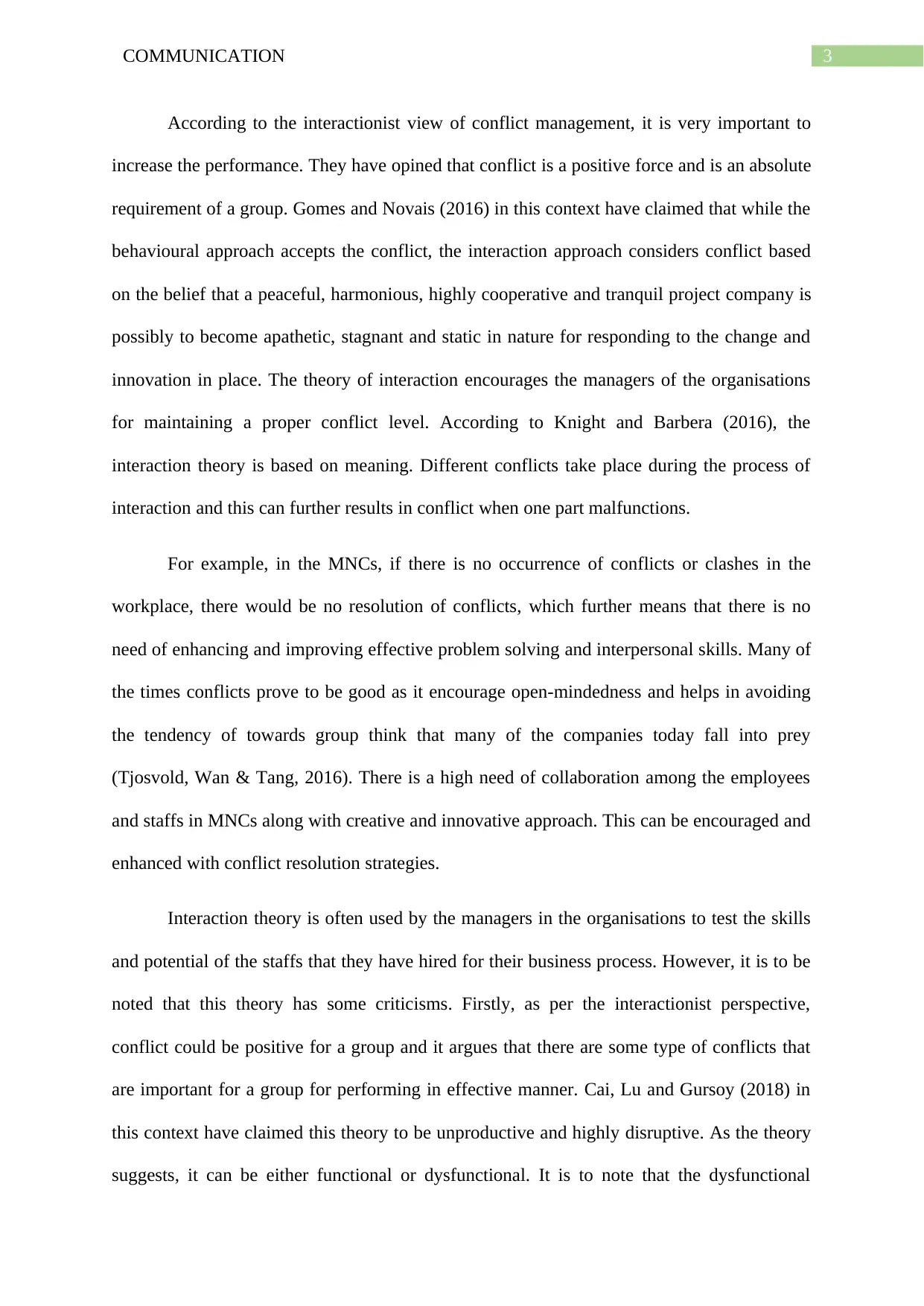
3COMMUNICATION
According to the interactionist view of conflict management, it is very important to
increase the performance. They have opined that conflict is a positive force and is an absolute
requirement of a group. Gomes and Novais (2016) in this context have claimed that while the
behavioural approach accepts the conflict, the interaction approach considers conflict based
on the belief that a peaceful, harmonious, highly cooperative and tranquil project company is
possibly to become apathetic, stagnant and static in nature for responding to the change and
innovation in place. The theory of interaction encourages the managers of the organisations
for maintaining a proper conflict level. According to Knight and Barbera (2016), the
interaction theory is based on meaning. Different conflicts take place during the process of
interaction and this can further results in conflict when one part malfunctions.
For example, in the MNCs, if there is no occurrence of conflicts or clashes in the
workplace, there would be no resolution of conflicts, which further means that there is no
need of enhancing and improving effective problem solving and interpersonal skills. Many of
the times conflicts prove to be good as it encourage open-mindedness and helps in avoiding
the tendency of towards group think that many of the companies today fall into prey
(Tjosvold, Wan & Tang, 2016). There is a high need of collaboration among the employees
and staffs in MNCs along with creative and innovative approach. This can be encouraged and
enhanced with conflict resolution strategies.
Interaction theory is often used by the managers in the organisations to test the skills
and potential of the staffs that they have hired for their business process. However, it is to be
noted that this theory has some criticisms. Firstly, as per the interactionist perspective,
conflict could be positive for a group and it argues that there are some type of conflicts that
are important for a group for performing in effective manner. Cai, Lu and Gursoy (2018) in
this context have claimed this theory to be unproductive and highly disruptive. As the theory
suggests, it can be either functional or dysfunctional. It is to note that the dysfunctional
According to the interactionist view of conflict management, it is very important to
increase the performance. They have opined that conflict is a positive force and is an absolute
requirement of a group. Gomes and Novais (2016) in this context have claimed that while the
behavioural approach accepts the conflict, the interaction approach considers conflict based
on the belief that a peaceful, harmonious, highly cooperative and tranquil project company is
possibly to become apathetic, stagnant and static in nature for responding to the change and
innovation in place. The theory of interaction encourages the managers of the organisations
for maintaining a proper conflict level. According to Knight and Barbera (2016), the
interaction theory is based on meaning. Different conflicts take place during the process of
interaction and this can further results in conflict when one part malfunctions.
For example, in the MNCs, if there is no occurrence of conflicts or clashes in the
workplace, there would be no resolution of conflicts, which further means that there is no
need of enhancing and improving effective problem solving and interpersonal skills. Many of
the times conflicts prove to be good as it encourage open-mindedness and helps in avoiding
the tendency of towards group think that many of the companies today fall into prey
(Tjosvold, Wan & Tang, 2016). There is a high need of collaboration among the employees
and staffs in MNCs along with creative and innovative approach. This can be encouraged and
enhanced with conflict resolution strategies.
Interaction theory is often used by the managers in the organisations to test the skills
and potential of the staffs that they have hired for their business process. However, it is to be
noted that this theory has some criticisms. Firstly, as per the interactionist perspective,
conflict could be positive for a group and it argues that there are some type of conflicts that
are important for a group for performing in effective manner. Cai, Lu and Gursoy (2018) in
this context have claimed this theory to be unproductive and highly disruptive. As the theory
suggests, it can be either functional or dysfunctional. It is to note that the dysfunctional
Paraphrase This Document
Need a fresh take? Get an instant paraphrase of this document with our AI Paraphraser
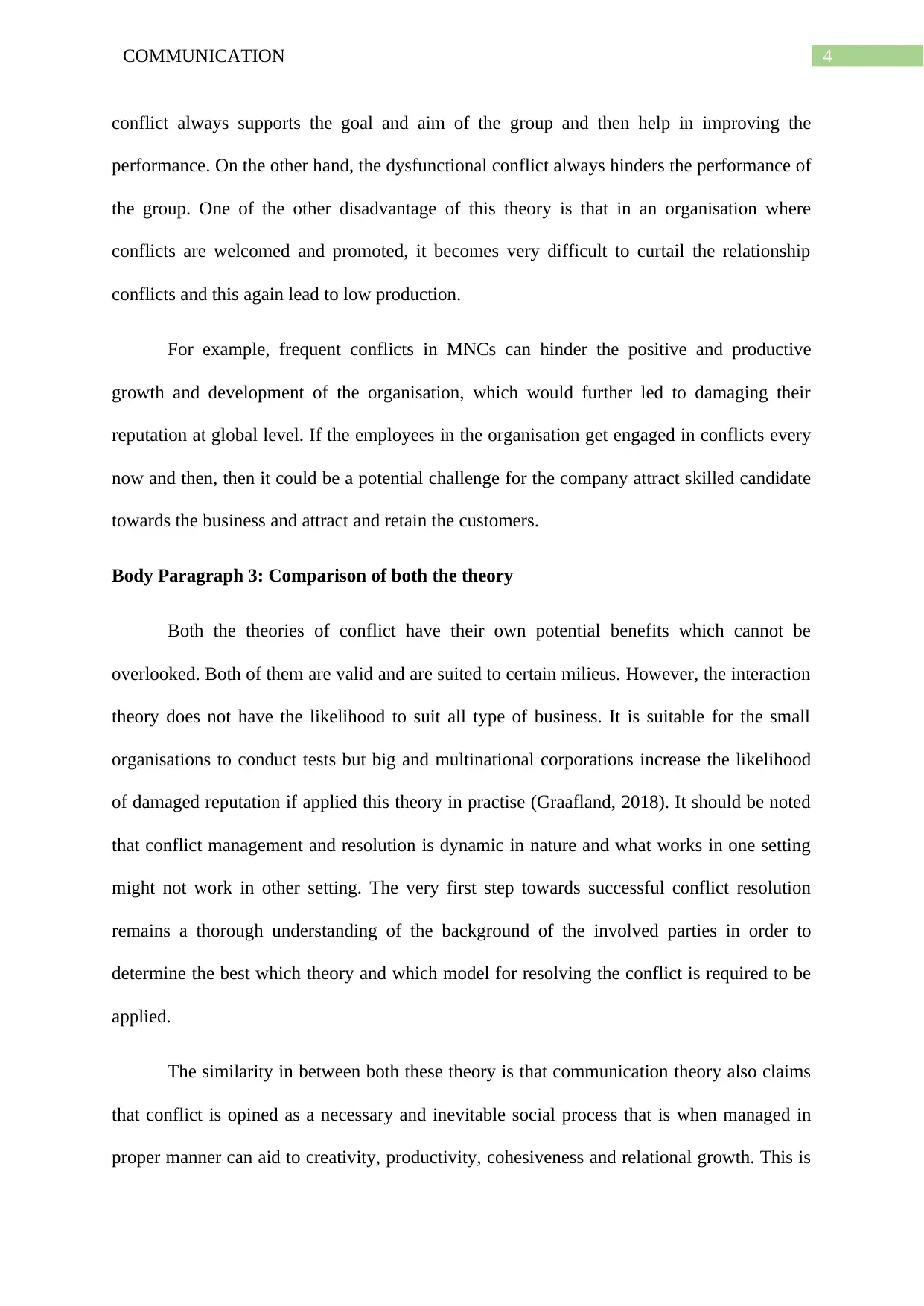
4COMMUNICATION
conflict always supports the goal and aim of the group and then help in improving the
performance. On the other hand, the dysfunctional conflict always hinders the performance of
the group. One of the other disadvantage of this theory is that in an organisation where
conflicts are welcomed and promoted, it becomes very difficult to curtail the relationship
conflicts and this again lead to low production.
For example, frequent conflicts in MNCs can hinder the positive and productive
growth and development of the organisation, which would further led to damaging their
reputation at global level. If the employees in the organisation get engaged in conflicts every
now and then, then it could be a potential challenge for the company attract skilled candidate
towards the business and attract and retain the customers.
Body Paragraph 3: Comparison of both the theory
Both the theories of conflict have their own potential benefits which cannot be
overlooked. Both of them are valid and are suited to certain milieus. However, the interaction
theory does not have the likelihood to suit all type of business. It is suitable for the small
organisations to conduct tests but big and multinational corporations increase the likelihood
of damaged reputation if applied this theory in practise (Graafland, 2018). It should be noted
that conflict management and resolution is dynamic in nature and what works in one setting
might not work in other setting. The very first step towards successful conflict resolution
remains a thorough understanding of the background of the involved parties in order to
determine the best which theory and which model for resolving the conflict is required to be
applied.
The similarity in between both these theory is that communication theory also claims
that conflict is opined as a necessary and inevitable social process that is when managed in
proper manner can aid to creativity, productivity, cohesiveness and relational growth. This is
conflict always supports the goal and aim of the group and then help in improving the
performance. On the other hand, the dysfunctional conflict always hinders the performance of
the group. One of the other disadvantage of this theory is that in an organisation where
conflicts are welcomed and promoted, it becomes very difficult to curtail the relationship
conflicts and this again lead to low production.
For example, frequent conflicts in MNCs can hinder the positive and productive
growth and development of the organisation, which would further led to damaging their
reputation at global level. If the employees in the organisation get engaged in conflicts every
now and then, then it could be a potential challenge for the company attract skilled candidate
towards the business and attract and retain the customers.
Body Paragraph 3: Comparison of both the theory
Both the theories of conflict have their own potential benefits which cannot be
overlooked. Both of them are valid and are suited to certain milieus. However, the interaction
theory does not have the likelihood to suit all type of business. It is suitable for the small
organisations to conduct tests but big and multinational corporations increase the likelihood
of damaged reputation if applied this theory in practise (Graafland, 2018). It should be noted
that conflict management and resolution is dynamic in nature and what works in one setting
might not work in other setting. The very first step towards successful conflict resolution
remains a thorough understanding of the background of the involved parties in order to
determine the best which theory and which model for resolving the conflict is required to be
applied.
The similarity in between both these theory is that communication theory also claims
that conflict is opined as a necessary and inevitable social process that is when managed in
proper manner can aid to creativity, productivity, cohesiveness and relational growth. This is
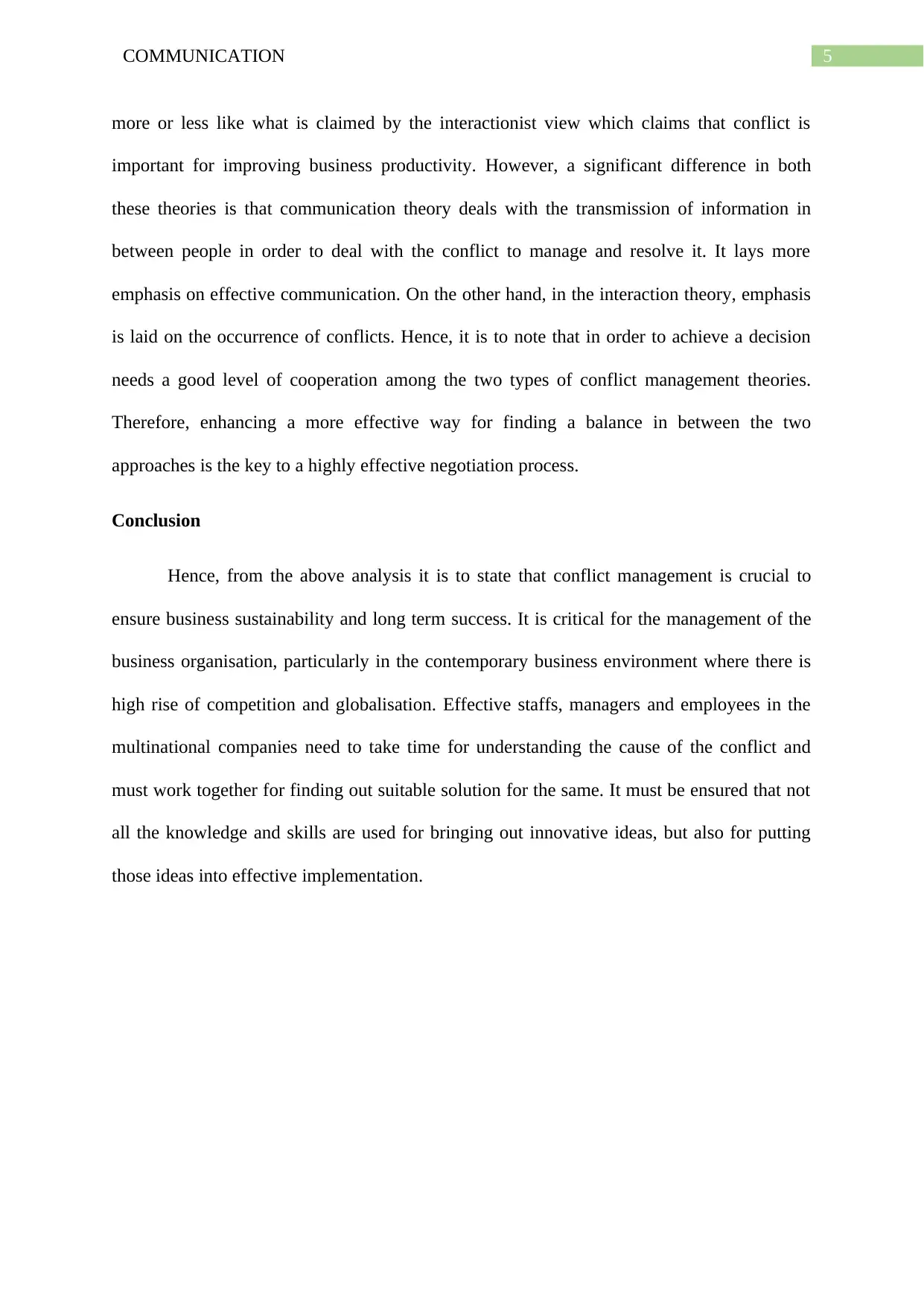
5COMMUNICATION
more or less like what is claimed by the interactionist view which claims that conflict is
important for improving business productivity. However, a significant difference in both
these theories is that communication theory deals with the transmission of information in
between people in order to deal with the conflict to manage and resolve it. It lays more
emphasis on effective communication. On the other hand, in the interaction theory, emphasis
is laid on the occurrence of conflicts. Hence, it is to note that in order to achieve a decision
needs a good level of cooperation among the two types of conflict management theories.
Therefore, enhancing a more effective way for finding a balance in between the two
approaches is the key to a highly effective negotiation process.
Conclusion
Hence, from the above analysis it is to state that conflict management is crucial to
ensure business sustainability and long term success. It is critical for the management of the
business organisation, particularly in the contemporary business environment where there is
high rise of competition and globalisation. Effective staffs, managers and employees in the
multinational companies need to take time for understanding the cause of the conflict and
must work together for finding out suitable solution for the same. It must be ensured that not
all the knowledge and skills are used for bringing out innovative ideas, but also for putting
those ideas into effective implementation.
more or less like what is claimed by the interactionist view which claims that conflict is
important for improving business productivity. However, a significant difference in both
these theories is that communication theory deals with the transmission of information in
between people in order to deal with the conflict to manage and resolve it. It lays more
emphasis on effective communication. On the other hand, in the interaction theory, emphasis
is laid on the occurrence of conflicts. Hence, it is to note that in order to achieve a decision
needs a good level of cooperation among the two types of conflict management theories.
Therefore, enhancing a more effective way for finding a balance in between the two
approaches is the key to a highly effective negotiation process.
Conclusion
Hence, from the above analysis it is to state that conflict management is crucial to
ensure business sustainability and long term success. It is critical for the management of the
business organisation, particularly in the contemporary business environment where there is
high rise of competition and globalisation. Effective staffs, managers and employees in the
multinational companies need to take time for understanding the cause of the conflict and
must work together for finding out suitable solution for the same. It must be ensured that not
all the knowledge and skills are used for bringing out innovative ideas, but also for putting
those ideas into effective implementation.
⊘ This is a preview!⊘
Do you want full access?
Subscribe today to unlock all pages.

Trusted by 1+ million students worldwide
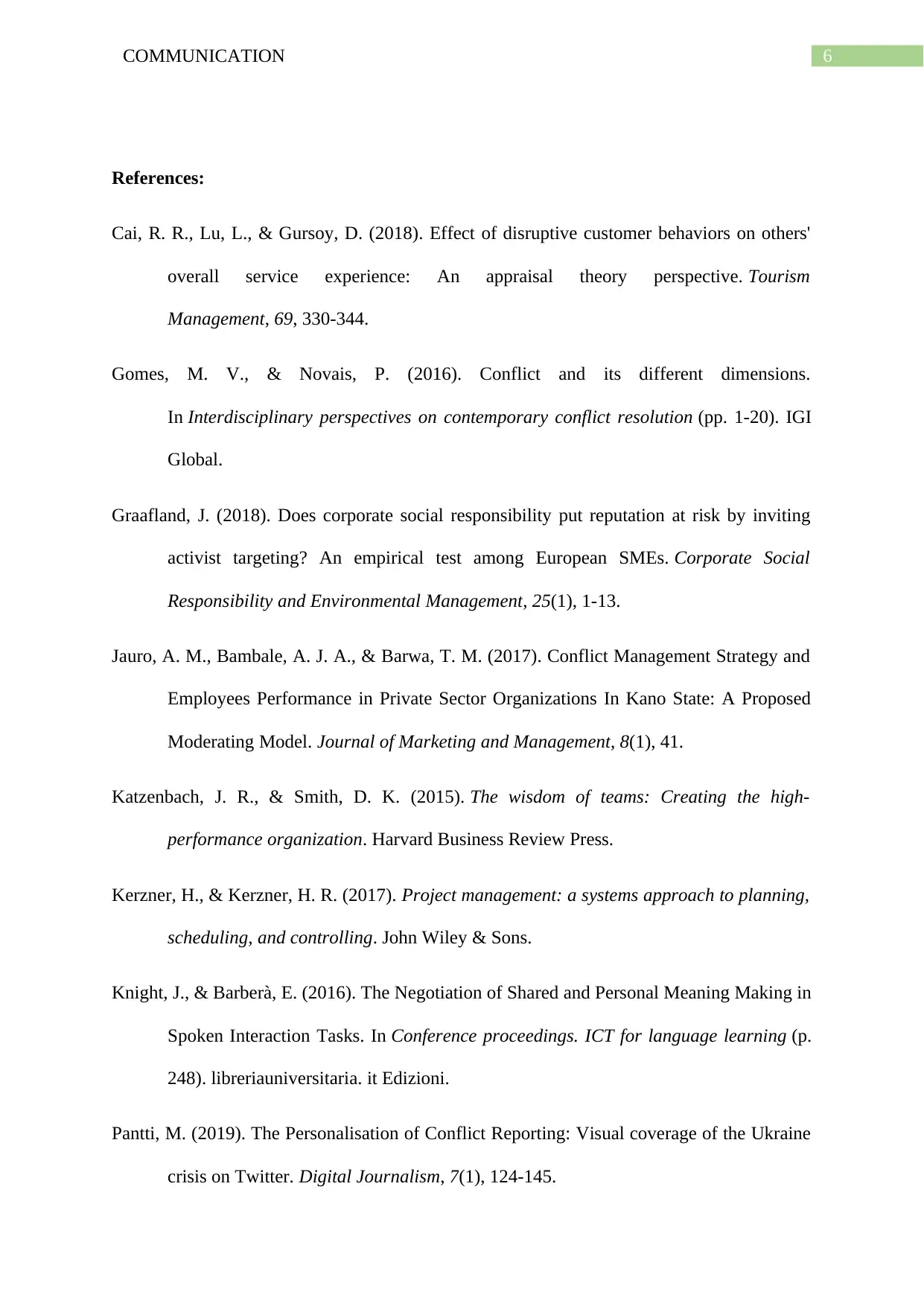
6COMMUNICATION
References:
Cai, R. R., Lu, L., & Gursoy, D. (2018). Effect of disruptive customer behaviors on others'
overall service experience: An appraisal theory perspective. Tourism
Management, 69, 330-344.
Gomes, M. V., & Novais, P. (2016). Conflict and its different dimensions.
In Interdisciplinary perspectives on contemporary conflict resolution (pp. 1-20). IGI
Global.
Graafland, J. (2018). Does corporate social responsibility put reputation at risk by inviting
activist targeting? An empirical test among European SMEs. Corporate Social
Responsibility and Environmental Management, 25(1), 1-13.
Jauro, A. M., Bambale, A. J. A., & Barwa, T. M. (2017). Conflict Management Strategy and
Employees Performance in Private Sector Organizations In Kano State: A Proposed
Moderating Model. Journal of Marketing and Management, 8(1), 41.
Katzenbach, J. R., & Smith, D. K. (2015). The wisdom of teams: Creating the high-
performance organization. Harvard Business Review Press.
Kerzner, H., & Kerzner, H. R. (2017). Project management: a systems approach to planning,
scheduling, and controlling. John Wiley & Sons.
Knight, J., & Barberà, E. (2016). The Negotiation of Shared and Personal Meaning Making in
Spoken Interaction Tasks. In Conference proceedings. ICT for language learning (p.
248). libreriauniversitaria. it Edizioni.
Pantti, M. (2019). The Personalisation of Conflict Reporting: Visual coverage of the Ukraine
crisis on Twitter. Digital Journalism, 7(1), 124-145.
References:
Cai, R. R., Lu, L., & Gursoy, D. (2018). Effect of disruptive customer behaviors on others'
overall service experience: An appraisal theory perspective. Tourism
Management, 69, 330-344.
Gomes, M. V., & Novais, P. (2016). Conflict and its different dimensions.
In Interdisciplinary perspectives on contemporary conflict resolution (pp. 1-20). IGI
Global.
Graafland, J. (2018). Does corporate social responsibility put reputation at risk by inviting
activist targeting? An empirical test among European SMEs. Corporate Social
Responsibility and Environmental Management, 25(1), 1-13.
Jauro, A. M., Bambale, A. J. A., & Barwa, T. M. (2017). Conflict Management Strategy and
Employees Performance in Private Sector Organizations In Kano State: A Proposed
Moderating Model. Journal of Marketing and Management, 8(1), 41.
Katzenbach, J. R., & Smith, D. K. (2015). The wisdom of teams: Creating the high-
performance organization. Harvard Business Review Press.
Kerzner, H., & Kerzner, H. R. (2017). Project management: a systems approach to planning,
scheduling, and controlling. John Wiley & Sons.
Knight, J., & Barberà, E. (2016). The Negotiation of Shared and Personal Meaning Making in
Spoken Interaction Tasks. In Conference proceedings. ICT for language learning (p.
248). libreriauniversitaria. it Edizioni.
Pantti, M. (2019). The Personalisation of Conflict Reporting: Visual coverage of the Ukraine
crisis on Twitter. Digital Journalism, 7(1), 124-145.
Paraphrase This Document
Need a fresh take? Get an instant paraphrase of this document with our AI Paraphraser
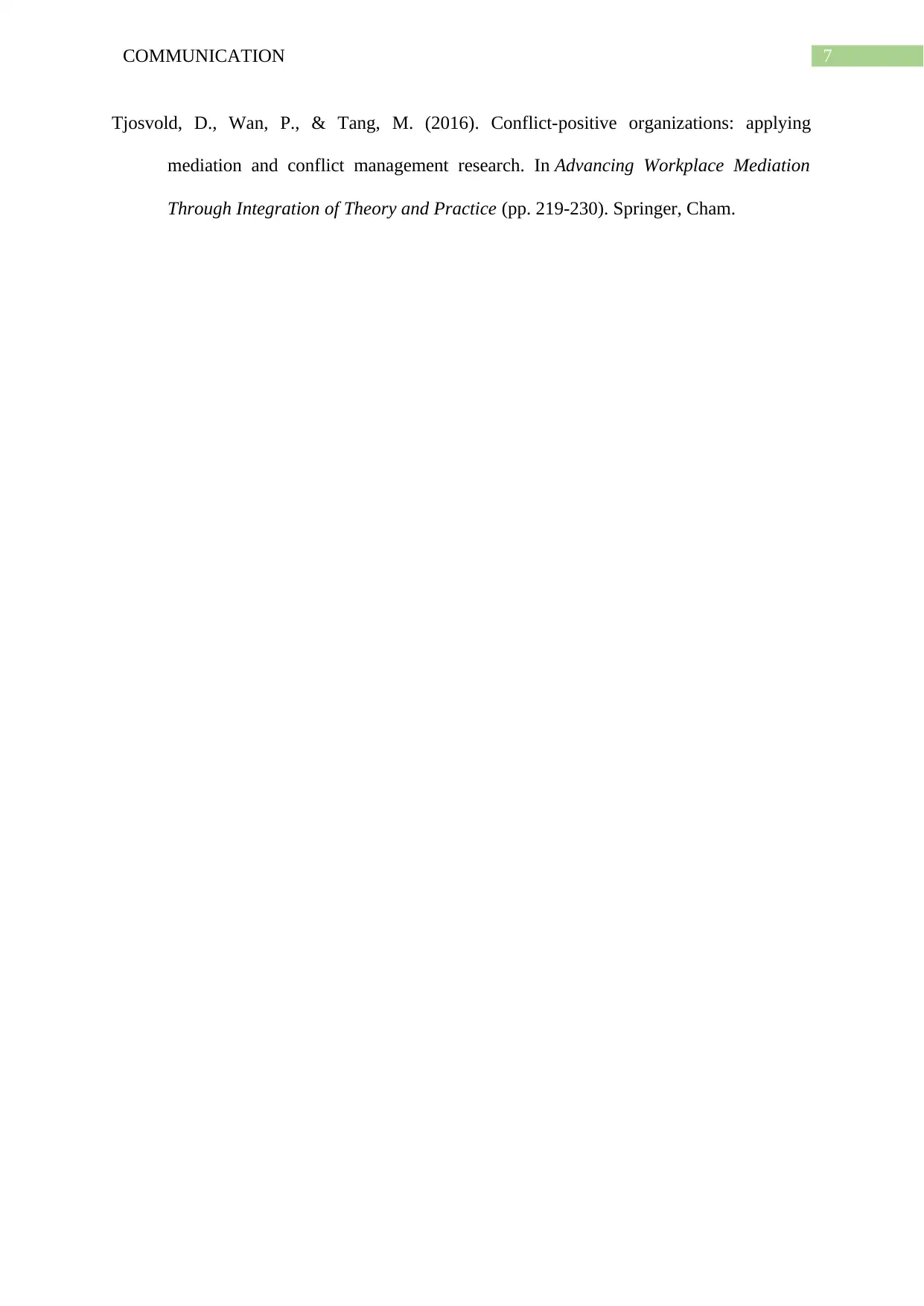
7COMMUNICATION
Tjosvold, D., Wan, P., & Tang, M. (2016). Conflict-positive organizations: applying
mediation and conflict management research. In Advancing Workplace Mediation
Through Integration of Theory and Practice (pp. 219-230). Springer, Cham.
Tjosvold, D., Wan, P., & Tang, M. (2016). Conflict-positive organizations: applying
mediation and conflict management research. In Advancing Workplace Mediation
Through Integration of Theory and Practice (pp. 219-230). Springer, Cham.
1 out of 8
Related Documents
Your All-in-One AI-Powered Toolkit for Academic Success.
+13062052269
info@desklib.com
Available 24*7 on WhatsApp / Email
![[object Object]](/_next/static/media/star-bottom.7253800d.svg)
Unlock your academic potential
Copyright © 2020–2025 A2Z Services. All Rights Reserved. Developed and managed by ZUCOL.





